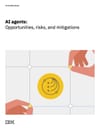📘 What’s Covered
This 15-page guide from IBM’s AI Ethics Board is designed to frame both the promise and pitfalls of AI agents, particularly as their capabilities grow more autonomous and embedded across industries. IBM defines AI agents as software entities that can autonomously perform tasks by interacting with tools, data, and sometimes other agents. These agents may range from simple rule-based bots to sophisticated, LLM-driven systems embedded in enterprise workflows.
The paper is structured around three core pillars: benefits, risks, and mitigations.
Benefits include:
- Human augmentation (e.g., SWE-1.0 to assist developers),
- Automation of enterprise functions (e.g., AskHR, handling 10M+ interactions),
- Decision support and productivity gains (e.g., Salesforce and life sciences deployments) .
Risks and societal impacts are mapped across several categories:
- Value misalignment and biased decision-making,
- Computational inefficiency and resource waste,
- Security vulnerabilities, privacy leaks, and manipulation,
- Reduced human dignity, job displacement, and compliance opacity .
IBM provides an extensive table of technical, social, and ethical risks—highlighting not just the challenges, but the reasons these risks are exacerbated in agentic systems (e.g., autonomy, opaqueness, open-endedness).
The final section focuses on governance and mitigations, including:
- IBM’s internal AI Ethics Board and Integrated Governance Program,
- AgentOps support in watsonx.ai, watsonx.governance, and IBM Guardium AI Security,
- Technical toolkits (AI Fairness 360, ITBench), red-teaming protocols, and human-in-the-loop frameworks,
- Educational efforts such as SkillsBuild and internal training programs .
💡 Why It Matters
As AI agents move from research to enterprise use, understanding how their autonomy introduces unique ethical and operational risks is crucial. This guide goes beyond abstract principles by detailing how IBM applies governance, metrics, and tooling to AI agent development. It offers a grounded view of real-world implementation challenges and the steps needed to build trust. Its emphasis on reproducibility, explainability, and accountability makes it highly relevant for policymakers, compliance officers, and AI teams building agentic systems.
🔍 What’s Missing
While the report offers a rich catalog of risk indicators and mitigation strategies, its practical guidance is mostly IBM-specific. Broader industry benchmarks or cross-sector governance comparisons are absent. The document doesn’t discuss agent regulation in emerging legal frameworks (e.g., EU AI Act) or how smaller organizations can replicate such governance infrastructure. It also doesn’t address systemic risks at societal scale (e.g., coordination failures, democratic accountability) in as much depth as technical risks.
🎯 Best For
Ideal for AI ethics leads, governance officers, and enterprise architects designing AI agent systems. Particularly helpful to those developing internal AI risk frameworks or deploying generative agents across complex workflows. Also valuable to researchers working on AI safety, trust, and robustness in applied settings.
📎 Source Details
- Title: AI Agents: Opportunities, risks, and mitigations
- Authors: IBM AI Ethics Board
- Published: March 2025
- Publisher: IBM Corporation
- Length: 15 pages
- Cited Tools: watsonx.ai, watsonx.governance, AI Fairness 360, ITBench, Granite Guardian


